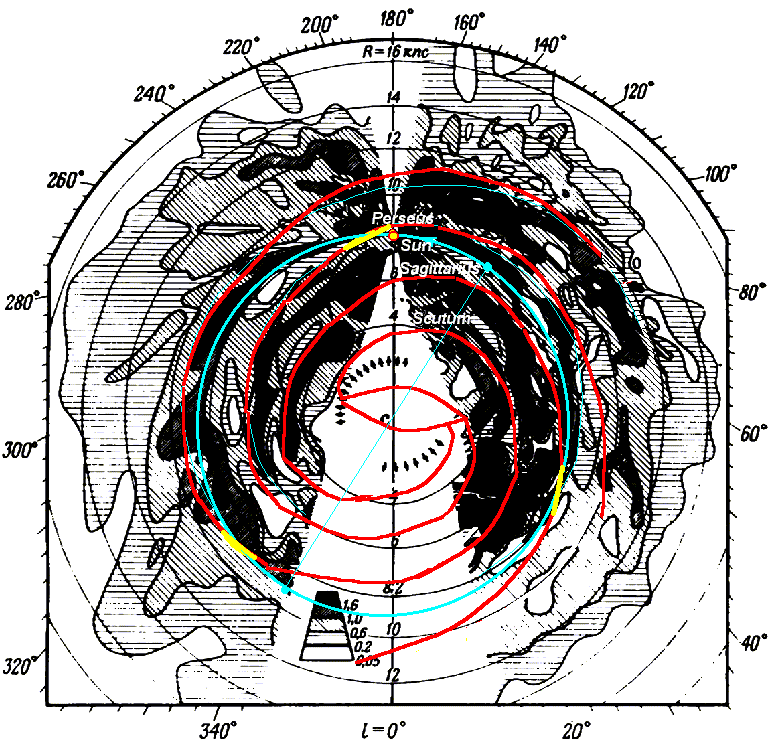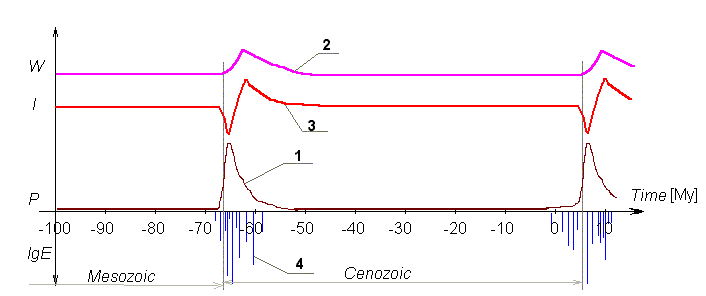
© Copyright - Karim A. Khaidarov, July 18, 2008
GALACTIC CHANGES OF AIRCRAFT ATTITUDE
To light memory of my daughter Анастасии I devote
ВСЕЛЕНСКИЕ CIRCULATIONS
Galactic circulation of substanceГосподь has created the man from asheses
[ Сирах 17:1]
As against extragalactic circulation of substance covering метагалактические open spaces, the galactic circulation closes inside a galaxy. The sowers of substance here are the not perishing galaxies, and perishing stars, that is observed as a phenomenon supernew.
As it was already marked, during the existence of a star slowly or fast, that depends on strongly varying concentration of interstellar substance, grow in weight, coming nearer to critical weight of nuclear explosion. If the conditions for this purpose were executed, there is an explosion, which the modern astrophysics names supernew. If the degenerating stars Кельвина blow up supernew
SN I, the stars of Main sequences containing essential quantity of metals and radiating in main(basic) at the expense of energy of an ether, blow up supernew SN II. In our Galaxy, as well as in other galaxies supernew blows up approximately of time per one century, that is part of an elementary cycle of galactic circulation of substance in a galaxy consisting from 10 11 Stars, takes about 10 billions years.However it only part of this cycle, as long time the star exists in a latent condition, when she(it) yet does not radiate in optical range. Time of changes of aircraft attitude of stars from cosmic dust up to brown dwarfs while to estimate very difficultly. Apparently, it is billions
years."Конденсатные" of a star differ by a plenty of metals in spectra. Old stars of the population
II, which orbits эволюционировали in the population I, in the majority already поглотили fair quantity of cosmic dust formed(educated) by explosions supernew and also have large or mean quantity of metals in spectra.The area of the galactic disk(disc) sated газопылевыми with complexes, cosmic dust and constantly inducing a cometary body, is a cradle of celestial bodies юпитерианского of a type. Last, on the average, have an identical chemical structure determined source - comets, which in turn there are children of explosions supernew.
When they grow up to the sizes of Jove, in them begins to act a phenomenon of radio heating described in
[44]. Gradually, collecting, as a vacuum cleaner smaller space bodies, they grow and transform to brown dwarfs, then red.There is a slow progress to more massive stars of Main sequence.
As for a long time was predicted Вильгельмом Гершелем and recently - Теодором Ландшайдтом, and as is proved to the author of the present activity, "конденсатные" of a star of Main sequence should have a firm nucleus. The size and behaviour of this nucleus in many respects is determined by(with) parameters of a star.
As it was already marked, the star of the galactic disk(disc) usually has a planetary system, that is determined by stability(immunity) of planetary niches(wells).
If there is a planetary system, the nucleus makes motions at the expense of disturbances on the part of planets. At his(its) motion inside a star there is an intensive exchange of substance to atmosphere of a star varying parameters of atmosphere and "растворяющий" a nucleus. Otherwise nucleus gradually grows, absorbing atmosphere.
The nuclear reactions really occur on these stars, but it not мифическая
pp-reaction. As in products of decay(disintegration) supernew there is a deuterium and тритий, uranium and торий, on stars спорадически there are conditions of nuclear explosion. On such stars, as the Sun it is shown by "solar activity" - flashes and magnetic storms. The share of a nuclear energy does not exceed for the Sun 1 % of his(its) power [57]. On red and brown dwarfs this share usually is higher, therefore they frequently are be by "wrong" variable stars (see tab. 2).As against stars Кельвина, a main(basic) power source of stars of Main sequence is the ether, and directly - asymmetry of exchange of energy of driving particles of substance with an ether. However presence or absence external (аккреция of gas) and internal (the nuclear activity) disturbances determines change of destiny of these stars.
At an input(entrance) in a galactic sleeve these stars frequently increase светимость for the account аккреции. But this short-term phenomenon passing through a little bit(some) сот of thousand - of millions of years after an output(exit) from dense clouds a sleeves.
The sun, moving on poorly elliptical orbit three times for a revolution (
~220 млн. Years) crosses sleeves of a Galaxy. It is visible from a card of distribution HI, where the sleeves take places of absence of radiation 21 see.Now Sun is close перигалактия, on distance
~8.2 кпс from center of a Galaxy and has speed of motion ~240 km / with, on 19,5 kms of above mean (circular) speed of ambient stars. In aphelions the Sun will defend on ~9.2 кпс from center and to have speed about 200 kms / c.The moments of interception of the Sun coincide sleeves of a Galaxy with global катаклизмами and change of the developmental periods of a biosphere of the Earth recurring on the average through 72 млн. Years (see fig. 12). It is natural, as at the moment of passage of a sleeve is sharply increased аккреция of gas, dust, comets born and in weight concentrated in gas clouds.
In the table 3 the moments of change палеонтологических of the periods, in accuracy conterminous with pass by the Sun of sleeves of a Galaxy are adduced.
At entering a Solar system in a galactic sleeve (at the moment of entering in dense газопылевые of a cloud) there is an increase of a dust content of near-earth space, and temperature on the Earth sharply drops. The period global оледенения begins. For example, tracks mineral оледенения 283 млн. Years(summer) prescription were found in India.
Then, because of same dust content there is an increase аккреционной светимости of the Sun. The equatorial zone of the Earth overheats so, that becomes unsuitable for life of the majority of kinds of animals and plants, and the climate in polar zones becomes tropical. Whether it is the reason of detection of minerals of the crocodiles in Antarctic Continent and mass formation(education) эвапоритов, - salt adjournment formed at temperature of a water 56ЁC? [71].
During passage the Solar system of sleeves sharply increases frequency of fall of cometary bodies by the Earth, that results in catastrophic consequences on the Earth.
Only periods of motion of the Sun in межрукавной to a zone are characterized by an equal, steady climate (see fig. 13).
Last change эр has taken place 65 - 67 млн. Years back, and today we enter in following change эр, the maximum катаклизмов with which will be through
5-7 млн. Years, that is through 1.3-1.5 кпс of a way. However process of entering in a galactic sleeve began already 2 млн. Years back, designated new, all becoming frequent ледниковыми by the periods (is so-called четвертичный the period), destruction of many kinds of large mammals (мамонты, пещерные bears, пещерные the people, саблезубые tigers:).The table 5. Палеонтологические the periods фанерозоя and moments of interception of galactic sleeves
|
The period |
Beginning |
The end млн. Years |
межпериодные of accident |
|
|
Кайнозой |
65 |
-5 |
Destruction of large mammals |
|
|
Мел |
137 |
67 |
Huge comet, destruction of dinosaurs |
|
|
Юра |
210 |
139 |
Destruction large flying ящеров and birds |
|
|
Perm - Триас |
280 |
211 |
Destruction large земноводных |
|
|
Карбон |
350 |
283 |
Destruction large членистоногих, хвощей, плаунов |
|
|
Силур-Девон |
420 |
355 |
Destruction of ancient fishes, папоротниковых |
|
|
Ордовик |
498 |
426 |
Destruction трилобитов |
|
|
Кембрий |
570 |
500 |
Destruction base флоры and фауны |
|

Fig. 12. The trajectory of motion the Sun in a Galaxy on a card of radiation of neutral hydrogen 21 см (is constructed on a card Лейденского of the review(view) [32])
( Red spirals - fronts of sleeves, light-blue ellipse - orbit of the Sun, yellow sections - place of entering of a Solar system in galactic sleeves)

Fig. 13. The temporary diagram of events at motion of the Sun in a Galaxy
( 1 - dust content of space, 2 - power of solar radiation, 3 - инсоляция on the Earth,
4 - the logarithm of power of cometary bombardment)
From three galactic sleeves - three catastrophic barriers: Perseus, Scutum, Sagittarius, most dusty for a Solar system is Scutum. His(its) Sun passes once for galactic year, and at this particular time arise global оледенения [72] (see tab. 6).
The table 6. Global and continental оледенения in a history of the Earth
|
The name |
Age млн. Years |
Sleeve |
|
Юрское global оледенение |
140 |
Scutum |
|
Coal global оледенение |
280 |
Saggitarius |
|
Вендское global оледенение |
570 |
Scutum |
|
Неопротерозойское оледенение |
790 |
Scutum |
|
Гуронское оледенение |
1000 |
Scutum |
|
Тимискаминское оледенение |
1200 |
Scutum |
|
Палеопротерозойское оледенение |
1650 |
Scutum |
|
Риасское оледенение |
2000 |
Saggitarius |
|
Неоархейское оледенение |
2650 |
Saggitarius |